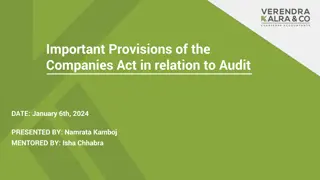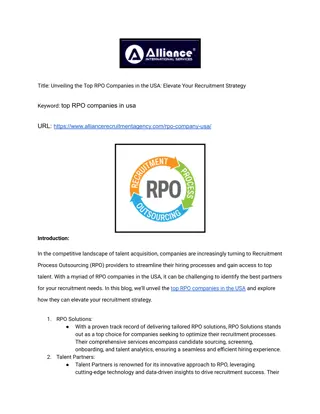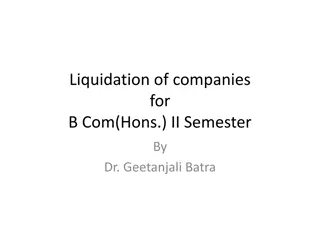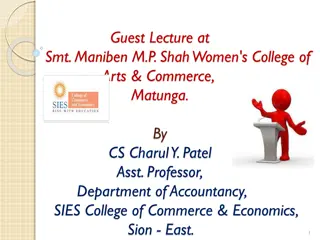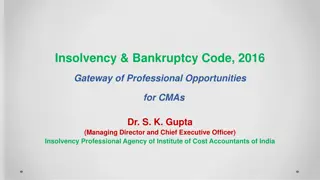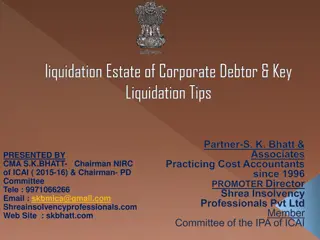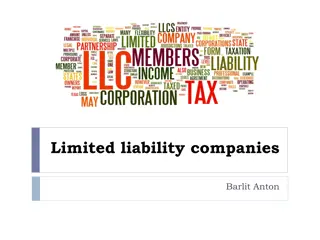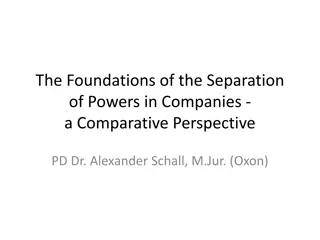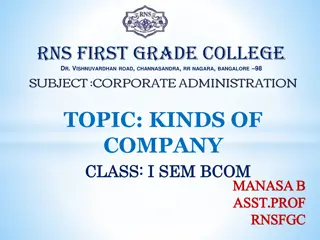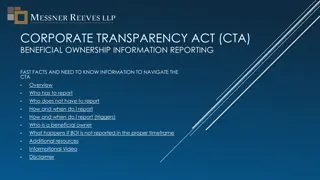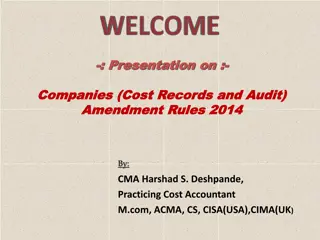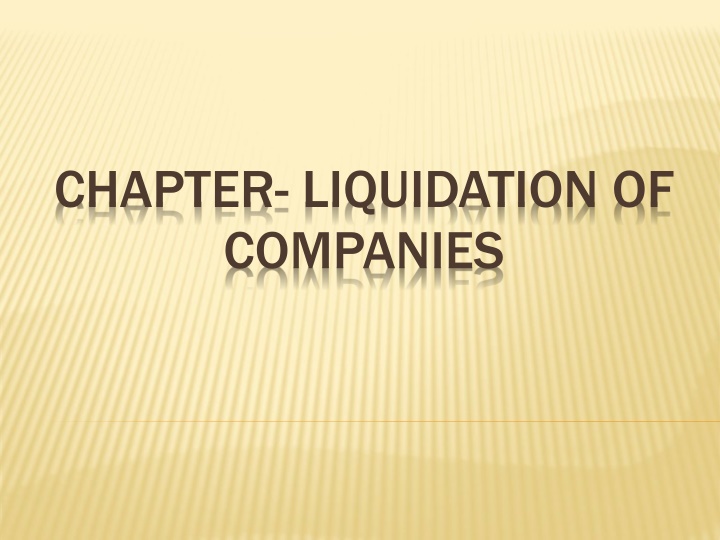
Liquidation and Winding-up of Companies
Learn the distinctions between liquidation and winding-up of companies, their meanings, differences, and modes. Discover when a company dissolves and the processes involved in each stage.
Download Presentation

Please find below an Image/Link to download the presentation.
The content on the website is provided AS IS for your information and personal use only. It may not be sold, licensed, or shared on other websites without obtaining consent from the author. If you encounter any issues during the download, it is possible that the publisher has removed the file from their server.
You are allowed to download the files provided on this website for personal or commercial use, subject to the condition that they are used lawfully. All files are the property of their respective owners.
The content on the website is provided AS IS for your information and personal use only. It may not be sold, licensed, or shared on other websites without obtaining consent from the author.
E N D
Presentation Transcript
CHAPTER- LIQUIDATION OF COMPANIES
LIQUIDATION OF COMPANIES Meaning Meaning- - 1) Meaning of Winding up: : Winding up is a means to dissolve a company and realize and use is assets in the payment of its debt. The winding up of a company is the process whereby its life is ended and its property is administered for the benefit of its creditors and members. 2) Meaning of Dissolution of a Company : : A company is said to be dissolved when it ceases to exist as a corporate entity. The dissolution puts an end to the existence of the company.
LIQUIDATION OF COMPANIES Difference Difference between and dissolution are used interchangeably. This is not correct. There are very important differences in these two terms which are given below- between Dissolution Dissolution and and Winding Winding up up of of a a Company Company: : Many times, the terms winding up Sr. No. Sr. No. Winding Winding up up Dissolution Dissolution 1. Winding up id one of the methods by which dissolution of a company is brought about. Dissolution is the end result of winding up of company. 2. Legal entity of the company continues at the commencement of the winding up. Dissolution brings about an end to the legal entity of the company, 3. A company may be allowed to continue its business as far it is necessary for the beneficial winding up of the company. Company ceases to exist on its dissolution. 4. Winding up is the first stage of ending the legal existence of the entity. Dissolution is the final stage after completion of winding up process. 5. The winding up process is handled by a liquidator / insolvency professional. The dissolution can happen only by way of an order passed by the Registrar. 6. Creditors can prove their claims during winding up. Creditors cannot do so on dissolution since the entity no longer exists. 7. Dissolution is always final. Winding up need not result in dissolution in all cases.
LIQUIDATION OF COMPANIES Winding Winding up Commonly, the expression winding up and liquidation are used interchangeably; however, there exist a line of difference between the two expressions. Winding up is a process of ending all the business affairs liquidation refers to selling off the assets of the company. up vs vs. . Liquidation Liquidation : : of the company and
LIQUIDATION OF COMPANIES Modes Modes of of Winding Winding up up : : Mode of Winding up Compulsory winding up Voluntary winding up Grounds other than inability to pay debits Inability to pay debits Upto 31stMarch, 2017 From 1stApril 2017 Insolvency and Bankruptcy Code Insolvency and Bankruptcy Code Companies Act. 2013 Companies Act. 2013
LIQUIDATION OF COMPANIES Winding Winding up A A company company may, Company Resolution- Against National Interests- Fraud- Default in Filing FS/AR- Just and Equitable- Petitions Petitions 1) Who can file- 2) Petition by Contributory- 3) Petition by Registrar- 4) Petition by Company- 5) Copy to Registrar- up by may, on by Tribunal Tribunal: : on a a petition petition u/s u/s 272 272, , be be wound wound up up by by the the Tribunal Tribunal when when a) b) c) d) e)
LIQUIDATION OF COMPANIES Statement Statement of of Affairs Petition by Company Petition by Others Procedure/Contents Lists: Statements of affairs should accompany eight lists: I) I) Assets Assets List A : Full particulars of every description of property not specifically pledged and included in any other list are to be set forth in this list. List B : Assets specifically pledged and creditors fully or partly secured. II) II) Liabilities Liabilities List C : Preferential creditors for rates, taxes, salaries, wages and other wise. List D : List of debenture holders secured by a floating charge. List E : Unsecured creditors. III) III) Share Share Capital Capital List F : List of Preference shareholders List G : List of Equity shareholders IV) IV) Deficiency Deficiency / / Surplus Surplus List H : Deficiency or surplus account. Affairs: : 1) 2) 3) 4)
LIQUIDATION OF COMPANIES Deficiency Deficiency Account Account : : The official liquidator will specify a date for period (minimum three years) beginning with the date on which information is supplied for preparation of an account to explain the deficiency or surplus. The deficiency account is divided into two parts : The first part starts with the deficit (on the given date) and contains every item that increases deficiency (or reduces surplus such as losses, dividends, etc.) The second part starts with the surplus on the given date and includes all profits. Overriding Overriding Preferential Preferential Payments Payments : : In the winding up of a company under this Act, the following debits should be paid in priority to all other debts : a) Workmen s dues; and b) Where a secured creditor has realized a secured asset
LIQUIDATION OF COMPANIES 1 1) ) Preferential Preferential Creditors In a winding up Preferential Creditors should be paid in priority to all other debts subject to the provisions of section 326. Preferential Creditors are as follows : a) Government Taxes b) Salary and Wages c) Holiday Remuneration d) Contribution under ESI Act e) Compensation f) PF, Pension Fund or Gratuity Fund g) Expenses of Investigation 2 2) ) Advance Advance 3 3) ) Debts Debts 4 4) ) Discharge Discharge 5 5) ) Distraint Distraint 6 6) ) Holiday/ Holiday/ Sick Sick leave leave Creditors : :
LIQUIDATION OF COMPANIES Effect Effect of of Floating Floating Charges Charges Where a company is being wound up, a floating charge on the undertaking or property of the company created within the 12 months immediately preceding the commencement of the winding up, should be invalid unless it is proved that the company immediately after the creation of the charge was solvent except fort the amount of any cash paid to the company at the time of and in consideration for or subsequent to the creation of the charge together with interest on that amount at the rate of 5 percent per annum or such other rate as may be notified by the Central Government in this behalf. Cost Cost of of Liquidation Liquidation All costs, charges and expenses incurred in winding up, including the remuneration of the liquidator are paid out of the assets of the company, in priority to all other claims. In case of voluntary winding up, the costs are paid in the following order a) Cost of liquidation, b) All expenses such as lawyers fees, tax on sale of assets arising after winding up order is passed, c) Remuneration of liquidator.
LIQUIDATION OF COMPANIES Liability Liability of of members Definition Definition According to S.2(26) of the Companies Act, 2013, the term contributory means, a person liable to contribute towards the assets of a company in the event of its being wound up. members as as contribution contribution Settling Settling the the List List According to section 285 as soon as may be after the passing of a winding up order by the Tribunal, the Tribunal shall settle a list of contributories. List List A A and and List List B B List A shows the names of the present members i.e. members whose names appear in the Register of members on the date of the winding up. List B shows the names of the past members who ceased to be members within one year from the commencement of the winding up.
LIQUIDATION OF COMPANIES Final Final Statement Statement of of Account Meaning Meaning In case of compulsory winding up, the company liquidator should keep proper books in such manner, as may be prescribed, in which he should cause entries or minutes to be made of proceedings at meetings and of such other matters as may be prescribed. Any creditor or contributory may, subject to the control of the Tribunal, inspect any such books, personally or through his agent. A statement showing summary or Receipts and Payments is known as the Liquidator s Statement of Account; such statement made when the winding up process is complete, is known as the Liquidator's Final Statement of Account. Account- -
THANK YOU!! Assistant Prof. Pradeep H. Tawade DEPARTMENT OF ACCOUNTANCY, NSS College of Commerce & Eco. Tardeo, Mumbai-34 Email ID pradeeptawade26@yahoo.com Mobile No. 9619491859

